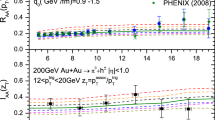Abstract
Hadronization, which is the process by which an energetic colored quark evolves into a color-singlet hadron in Quantum Chromodynamics, can be studied both in small nuclei and large nuclei, and the comparison of the differences between those two systems provides information about the hadronization mechanisms on femtometer distance scales. It can be argued that this process is well understood for light meson production on nuclei, but data from HERMES and CLAS for baryon production present puzzling patterns that are not well described by models. Herein we suggest that this might be due to the presence of diquarks in the protons and neutrons making up these nuclei.



Similar content being viewed by others
References
A. Airapetian, N. Akopov, Z. Akopov et al., Multidimensional study of hadronization in nuclei. Eur. Phys. J. A 47(9), 1–8 (2011). https://doi.org/10.1140/epja/i2011-11113-5
M. Barabanov, M. Bedolla, W. Brooks et al., Diquark correlations in hadron physics: Origin, impact and evidence. Progress Particle Nuclear Phys. 116, 103835 (2021). https://doi.org/10.1016/j.ppnp.2020.103835
W.K. Brooks, J.A. López, Estimating the color lifetime of energetic quarks. Phys. Lett. B 816, 136171 (2021). https://doi.org/10.1016/j.physletb.2021.136171
O. Buss, T. Gaitanos, K. Gallmeister et al., Transport-theoretical description of nuclear reactions. Phys. Rep. 512(1–2), 1–124 (2012). https://doi.org/10.1016/j.physrep.2011.12.001
T. Chetry, L. El Fassi, W. K. Brooks, R. Dupré, A. El Alaoui, K. Hafidi et al. (CLAS Collaboration) First measurement of \(\Lambda \) electroproduction off nuclei in the current and target fragmentation regions. Phys. Rev. Lett. 130(14), 142301 (2023). https://doi.org/10.1103/PhysRevLett.130.142301. arXiv:2210.13691 [nucl-ex]
B. Guiot, B.Z. Kopeliovich, Spacetime development of in-medium hadronization: scenario for leading hadrons. Phys. Rev. C 102(4), 045201 (2020). https://doi.org/10.1103/physrevc.102.045201
E. Molina, Experimental measurement and phenomenological study of positive pion production in nuclear media. Master’s thesis, Universidad Técnica Federico Santa María, (2022). https://repositorio.usm.cl/handle/11673/53373
S. Morán, R. Dupre, H. Hakobyan et al., Measurement of charged-pion production in deep-inelastic scattering off nuclei with the CLAS detector. Phys. Rev. C 105(1), 015201 (2022). https://doi.org/10.1103/physrevc.105.015201
S. Paul, S. Morán, M. Arratia et al., observation of azimuth-dependent suppression of hadron pairs in electron scattering off nuclei. Phys. Rev. Lett. 129(18), 182501 (2022). https://doi.org/10.1103/physrevlett.129.182501
The CLAS Hadronization Collaboration Jefferson Lab Experiment E06-117: Quark Propagation and Hadron Formation. Link: https://misportal.jlab.org/mis/physics/experiments/viewProposal.cfm?paperId=485 (2006)
William K. Brooks, Jefferson Lab Experiment E02-104: Quark Propagation and Hadron Formation. Link: https://misportal.jlab.org/mis/physics/experiments/viewProposal.cfm?paperId=189 (2002)
P.L. Yin, C. Chen, G. Krein et al., Masses of ground-state mesons and baryons, including those with heavy quarks. Phys. Rev. D 100(3), 034008 (2019). https://doi.org/10.1103/physrevd.100.034008
Acknowledgements
WKB acknowledges partial financial support by the Center for Science and Technology of Valparaiśo, Chile, under the PIA/APOYO AFB180002 grant from the Chilean ANID funding agency. WKB also acknowledges partial financial support by the ANID - Millennium Science Foundation - ICN2019_044. LE acknowledges partial financial support from US DOE grant number DE-FG02-07ER41528.
Author information
Authors and Affiliations
Corresponding author
Ethics declarations
Conflict of interest
We declare that we, the authors, have no competing interests as defined by Springer, or other interests that might be perceived to influence the results and/or discussion reported in this paper. WB wrote the manuscript, it was reviewed and improved by LE, LE and TC performed the data analysis referred to in this work.
Additional information
Publisher's Note
Springer Nature remains neutral with regard to jurisdictional claims in published maps and institutional affiliations.
Rights and permissions
Springer Nature or its licensor (e.g. a society or other partner) holds exclusive rights to this article under a publishing agreement with the author(s) or other rightsholder(s); author self-archiving of the accepted manuscript version of this article is solely governed by the terms of such publishing agreement and applicable law.
About this article
Cite this article
Brooks, W.K., El Fassi, L. & Chetry, T. Exploring the Potential Role of Diquarks in Hadronization Using Semi-inclusive Deep Inelastic Scattering on Nuclear Targets. Few-Body Syst 64, 61 (2023). https://doi.org/10.1007/s00601-023-01822-z
Received:
Accepted:
Published:
DOI: https://doi.org/10.1007/s00601-023-01822-z




